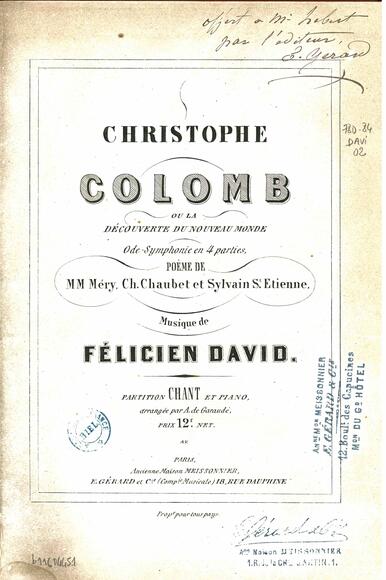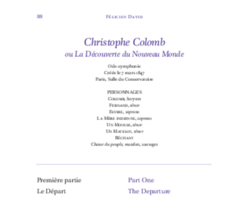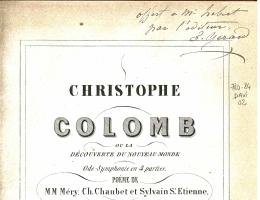Christophe Colomb ou La Découverte du Nouveau Monde

Ode-symphonie in four parts.
Performed for the first time on 7 March 1847 at the Paris Conservatoire, Christophe Colomb ou la Découverte du Nouveau-Monde is a four-part “ode-symphonie” to a libretto by Joseph-François Méry, Charles Chaubet and Sylvain de Saint-Étienne. Although the work is less well known than Le Désert, which was David’s first “ode-symphonie”, it nonetheless provides a fine example of the possibilities afforded by this hybrid genre, partway between a symphony, a melodrama and an oratorio. The work describes the epic journey of Christopher Columbus in four parts: “Le depart” (Departure), “Une nuit sur l’océan” (A Night on the Ocean), “La Révolte” (The Rebellion) and “Le Nouveau-Monde” (The New World). In the first part, Columbus appears on the shores of the Atlantic, gazing out to sea, as if he could already see the New World. The crew sails away from terra firma to the sound of the betrothed couple’s farewell song, which is followed by a prayer sung by all to invoke heavenly protection. The second part sees the sailors encountering the vagaries of the ocean, an element which is by turns calm—giving rise to passages of infinite poetry tinged with profound nostalgia—and stormy—which David’s music expresses just as forcefully. “La Révolte” describes the mutiny by the sailors who, afraid of dying, want to sacrifice Columbus. He convinces them to take fresh heart in a passage reminiscent of the “Chœur de la révolte” from Spontini’s Fernand Cortez (1809). This part was added at the last minute by the composer. In the final scene, the exoticism of the New World is introduced by the singing and dancing of the savages. Like Le Désert, the work contains beliefs held dear by David, the official composer of the Saint-Simonians since 1831. The first version of the work had a very similar structure to that of the previous “ode-symphonie”, which was in three parts (and it is worth remembering that Le Désert also begins with a departure and ends with a sunrise).
Focuses
Focus


